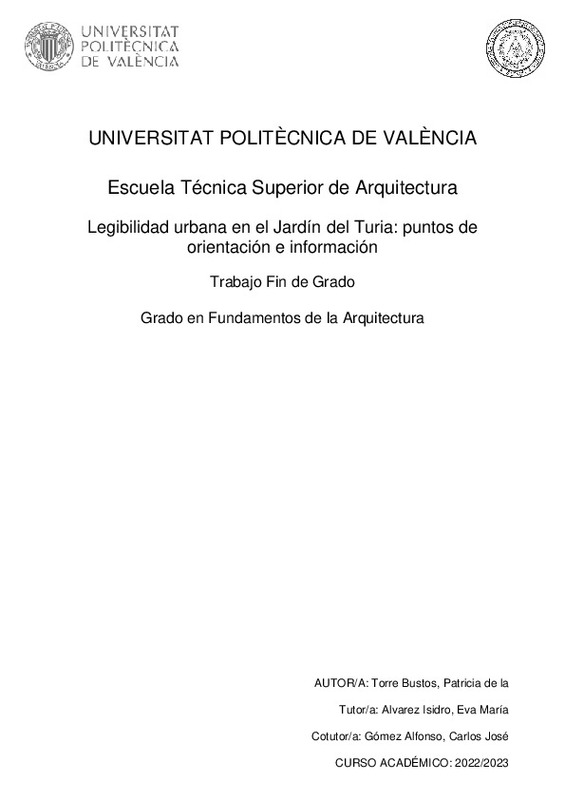JavaScript is disabled for your browser. Some features of this site may not work without it.
Buscar en RiuNet
Listar
Mi cuenta
Estadísticas
Ayuda RiuNet
Admin. UPV
Legibilidad urbana en el Jardín del Turia: puntos de orientación e información
Mostrar el registro sencillo del ítem
Ficheros en el ítem
| dc.contributor.advisor | Alvarez Isidro, Eva María
|
es_ES |
| dc.contributor.advisor | Gómez Alfonso, Carlos José
|
es_ES |
| dc.contributor.author | de la Torre Bustos, Patricia
|
es_ES |
| dc.date.accessioned | 2023-12-26T12:23:12Z | |
| dc.date.available | 2023-12-26T12:23:12Z | |
| dc.date.created | 2023-09-28 | |
| dc.date.issued | 2023-12-26 | es_ES |
| dc.identifier.uri | http://hdl.handle.net/10251/201104 | |
| dc.description.abstract | [ES] Desde las primeras civilizaciones, Valencia ha estado fuertemente ligada al río Turia, siendo el lugar elegido para los distintos asentamientos próximo al río y, a lo largo del tiempo, creciendo y desarrollándose en torno a este. Actualmente, su apariencia es la de un gran jardín lineal, un pulmón verde que atraviesa la ciudad permitiendo su conexión entre esta y el mar. Sin embargo, pese a su posición privilegiada en la ciudad, resulta especialmente complicado para aquellos que transitan el Jardín del Turia identificar en qué parte de la ciudad de Valencia se encuentran en cada momento. Esto es debido a estar situado a una cota inferior del nivel de la calle, por haber sido en su origen un cauce fluvial, lo cual proporciona tranquilidad, pero también genera cierta sensación de aislamiento y, en algunos casos, inseguridad. En consecuencia, el objetivo del presente Trabajo de Final de Grado es conocer la estructura urbana del Jardín del Turia y su entorno más inmediato y detectar aquello que obstaculiza y que permite la orientación de las personas en la ciudad, con la intención de mejorar la legibilidad urbana y así conseguir que sea un espacio más inclusivo. Para ello se estudiarán proyectos en los que la orientación de las personas es un elemento de partida, como son los proyectos de City ID y el sistema ¿Wayfinding¿, y posteriormente se aplicará su metodología al propio jardín, teniendo en cuenta constantemente el punto de vista del peatón y, por tanto, aplicando la perspectiva de género. | es_ES |
| dc.description.abstract | [EN] Since the earliest civilizations, Valencia has been strongly linked to the Turia River, being the place chosen for the different settlements near the river and, over time, growing and developing around it. Nowadays, its appearance is that of a great linear garden, a green lung that crosses the city allowing its connection between it and the sea. However, despite its privileged position in the city, it is especially difficult for those who walk through the Turia Garden to identify in which part of the city of Valencia they are at any moment. The reason is that it is located at a lower level than the one of the streets, as it was originally a riverbed, which provides peacefulness, but also generates a certain sense of isolation and, in some cases, insecurity. Consequently, the objective of this Final Degree Project is to understand the urban structure of the Turia Garden and its immediate surroundings and to detect what is an obstacle and what enables people to find their way around the city, with the intention of improving urban legibility and thus making it a more inclusive space. For this purpose, projects in which people's orientation is a starting point, such as the City ID projects and the "Wayfinding" system, will be studied, and their methodology will then be applied to the garden itself, constantly considering the pedestrian's point of view and, therefore, applying the gender perspective. | es_ES |
| dc.format.extent | 69 | es_ES |
| dc.language | Español | es_ES |
| dc.publisher | Universitat Politècnica de València | es_ES |
| dc.rights | Reserva de todos los derechos | es_ES |
| dc.subject | Perspectiva de género | es_ES |
| dc.subject | Urbanismo | es_ES |
| dc.subject | Jardín del Turia | es_ES |
| dc.subject | Parque urbano | es_ES |
| dc.subject | Valencia | es_ES |
| dc.subject | Legibilidad urbana | es_ES |
| dc.subject | Wayfinding | es_ES |
| dc.subject | Urban planning | es_ES |
| dc.subject | Turia Garden | es_ES |
| dc.subject | Urban park | es_ES |
| dc.subject | Urban legibility | es_ES |
| dc.subject | Gender perspective | es_ES |
| dc.subject.classification | PROYECTOS ARQUITECTONICOS | es_ES |
| dc.subject.other | Grado en Fundamentos de la Arquitectura-Grau en Fonaments de l'Arquitectura | es_ES |
| dc.title | Legibilidad urbana en el Jardín del Turia: puntos de orientación e información | es_ES |
| dc.title.alternative | Urban legibility in the Turia Garden: orientation and information points | es_ES |
| dc.title.alternative | Llegibilitat urbana al Jardí del Túria: punts d'orientació i informació | es_ES |
| dc.type | Proyecto/Trabajo fin de carrera/grado | es_ES |
| dc.rights.accessRights | Abierto | es_ES |
| dc.contributor.affiliation | Universitat Politècnica de València. Departamento de Proyectos Arquitectónicos - Departament de Projectes Arquitectònics | es_ES |
| dc.contributor.affiliation | Universitat Politècnica de València. Escuela Técnica Superior de Arquitectura - Escola Tècnica Superior d'Arquitectura | es_ES |
| dc.description.bibliographicCitation | De La Torre Bustos, P. (2023). Legibilidad urbana en el Jardín del Turia: puntos de orientación e información. Universitat Politècnica de València. http://hdl.handle.net/10251/201104 | es_ES |
| dc.description.accrualMethod | TFGM | es_ES |
| dc.relation.pasarela | TFGM\151566 | es_ES |
Este ítem aparece en la(s) siguiente(s) colección(ones)
-
ETSA - Trabajos académicos [4687]
Escuela Técnica Superior de Arquitectura






